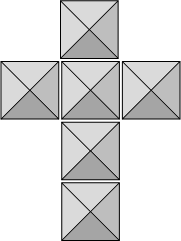Turn Two Cubes into a Rhombic Dodecahedron II

This model illustrates an interesting connection between a cube and a rhombic dodecahedron (a twelve-sided polygon that has rhombi for faces). You can essentially turn a cube inside out and drape it over another cube to form a rhombic dodecahedron.
Steps
- Cut out six copies of the small pattern pieces.
- Fold and glue them to create six square pyramids.
 Tape the square bases of the pyramids together so they form a shape of a cross. Leave a gap of 1 - 2mm (1/16 of an inch) between the pyramids depending on the thickness of the paper you are using. The gap helps the pyramids fold up to form a cube.
Tape the square bases of the pyramids together so they form a shape of a cross. Leave a gap of 1 - 2mm (1/16 of an inch) between the pyramids depending on the thickness of the paper you are using. The gap helps the pyramids fold up to form a cube.- Cut out one copy of the net of a cube, fold it up, and glue it.
- Turn the cube made of pyramids "inside out" and drape it over the cube so each pyramid base rests on the face of the solid cube. The resulting solid is a rhombic dodecahedron.
Notes
- You can think of a rhombic dodecahedron as a stellation of the cube. Each pyramid in this model extends the face of a cube.
-
The acute angles in the rhombi that make up the dodecahedron have a measure that is the inverse cosine of 1/3. This is also the angle formed at the intersection of two body diagonals of a cube so it shows up in the pyramids.
References
Comments
comments powered by Disqus
